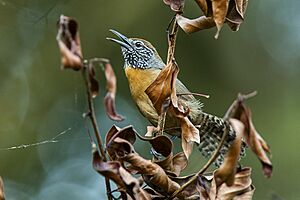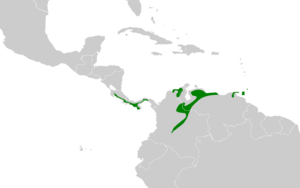Rufous-breasted wren facts for kids
Quick facts for kids Rufous-breasted wren |
|
|---|---|
 |
|
| In Panama | |
| Conservation status | |
| Scientific classification | |
| Genus: |
Pheugopedius
|
| Species: |
rutilus
|
 |
|
| Synonyms | |
|
Thryothorus rutilus |
|
The rufous-breasted wren (Pheugopedius rutilus) is a small songbird known for its pretty songs. It belongs to the family of wrens, called Troglodytidae. You can find this bird in several countries, including Colombia, Costa Rica, Panama, Trinidad and Tobago, and Venezuela.
Contents
About the Rufous-breasted Wren
The Rufous-breasted wren used to be grouped with other wrens in a different genus called Thryothorus. But scientists, who study and classify animals, decided it fit better in the Pheugopedius genus. It is also very closely related to the speckle-breasted wren and the spot-breasted wren. These three birds are so similar that they are considered a "superspecies," meaning they are a very close group of related species.
There are seven different types, or subspecies, of the Rufous-breasted wren:
- P. r. hyperythrus
- P. r. tobagensis
- P. r. rutilus
- P. r. intensus
- P. r. laetus
- P. r. interior
- P. r. hypospodius
What Does It Look Like?
Adult Rufous-breasted wrens are about 14 cm (5.5 inches) long. They weigh between 13.5 and 18.5 grams (about half an ounce). Their head and upper body are a warm brown color. Their tail is gray-brown with dark brown stripes.
They have a white stripe above their eye, which has a black edge. Their face and throat are speckled with black and white spots. The most noticeable part is their chest, which is a bright chestnut color. The rest of their belly is a duller chestnut with a grayish-white center. Young wrens are not as brightly colored as adults, and their face markings are not as clear. The unique face pattern and the rufous (reddish-brown) chest make this wren easy to identify among other wrens in its genus.
Subspecies Differences
Each subspecies has slight differences in appearance:
- P. r. hyperythrus looks like the main type but has blackish spots on its chest.
- P. r. laetus also has blackish spots, and its underparts are richer in color.
- P. r. hypospodius has more reddish colors on its head and back. Its chest is more yellowish-brown, and its sides are duller.
- P. r. interior has pale yellow underparts and pale olive-brown sides.
- P. r. intensus is more brightly colored than the main type and often has some spots.
- P. r. tobagensis has a stronger beak and longer wings. Its chest color is also duller.
Where Does It Live?
The different subspecies of the Rufous-breasted wren live in specific areas:
- P. r. hyperythrus lives on the Pacific side of Costa Rica and western Panama.
- P. r. tobagensis is found on the island of Tobago.
- P. r. rutilus lives in the Coastal Range of northern Venezuela. It also lives on both sides of the Andes mountains in northwestern Venezuela and on the island of Trinidad.
- P. r. intensus is found in the Táchira state of southwestern Venezuela.
- P. r. laetus lives in far northern Colombia and nearby northern Venezuela.
- P. r. interior is found on the western side of Colombia's Eastern Andes mountains.
- P. r. hypospodius lives on the eastern side of Colombia's Eastern Andes mountains.
This bird lives in rainforests and cloudforests. It prefers areas with thick bushes, new plant growth, and the edges of forests, rather than deep inside the forest. You can find it from sea level up to about 1,900 meters (6,200 feet) high.
Behavior
Feeding Habits
Rufous-breasted wrens usually search for food in pairs or small family groups. They mostly look for food in the low bushes and plants, but sometimes they go higher into the trees. Their main diet includes insects like beetles, bugs, and flies. They also eat spiders. Sometimes, they have been seen eating seeds, and even small frogs or lizards!
Reproduction
The Rufous-breasted wren builds a large, round nest. It is made of leaves and grass and has an entrance on the side. The nest is hidden in tangled plants, sometimes as high as 12 meters (39 feet) above the ground. The female wren lays two to four eggs and sits on them to keep them warm. Only the female incubates the eggs, but both parents work together to feed the baby birds once they hatch.
Vocalization
The songs of the Rufous-breasted wren can sound different depending on where the bird lives. Both the male and female wrens often sing together in a duet. Sometimes, the male will sing by himself. You can listen to examples of their songs from different places:
- Costa Rica: [1]
- Panama: [2]
- Colombia: [3]
- Venezuela: [4]
- Trinidad: [5]
Their call, which sounds "churring and raspy," seems to be more consistent across their range: [6].
Conservation Status
The IUCN (International Union for Conservation of Nature) has evaluated the Rufous-breasted wren. They have listed it as a species of "Least Concern." This means that the bird is not currently in danger of disappearing. It is quite common in many areas where it lives and can be found in several protected natural parks.


